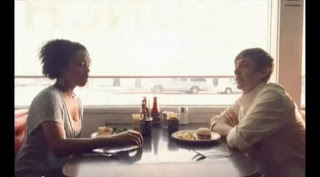The short film I'm analyzing is "Who's Gonna Save My Soul?" directed by Chris Milk. While the film takes its name from a Gnarls Barkley song and exists mainly to promote said song, it is not necessarily a music video; however, the song can be heard prominently throughout. It depicts a break-up that is difficult for one party but not the other.
 |
| That is indeed his heart on the plate. |
 |
| The third and fourth people to appear are the waitress and the patron at the counter, respectively. |
Again, there is little to no notable detail aside from the characters. The cinematographer's clear intention was for the focus to remain on the subjects and plot more than anything else. Until the heart becomes sentient, the presence of other people is rarely even acknowledged--a grand total of three humans appear before that shot.
Lastly, the lighting and color. The film uses a "mid-key" lighting scheme. While there are shadows that indicate a more somber tone, sunlight contrasts this in order to lighten the mood. There is a color scheme that may or may not be intentional: the Caucasian man, wearing a light yellow dress shirt, versus the African-American woman, dressed in a gray shirt.


So I really liked your choice in film, this was a very good short film with a lot of underlying themes and messages. Your analysis of shots, angles, and intent was good but I felt that there could have been more focus on the sound. It's understandable that you want to avoid the idea of this as a music video, but it would have been good to talk about the symbolism in the lyrics, as the man is giving his soul away and needs saving from depression, as the song says. I also feel that you could have discussed the metaphor of the heart and what the man says as a representation for what happens in the real world to not only men but people in general who have their hearts broken. But overall I'd say this was a great choice in film; your use of vocab and analysis was great and you did a good job.
ReplyDeleteWell your analysis of the shots were good, but i felt like you could have gone more in depth with the directors reason for these shots or what meaning he was trying to grasp. Also you could have taken into account how maybe the director was looking for a more literal meaning in his shots to match the song, which would suggest the directors lack of focus on some shots. I also felt that the director remained heavly on the juxtaposition of the shots to get the overall story out to the audience. Thus i thought you did good on your analysis, but could have gone deeper.
ReplyDeleteIt seems like you payed a lot of attention to the shots (as did I) and didn't spend as much time on everything else. I don't believe you directly stated the style of the director either, but you had a wide use of the vocabulary of cinematography which was definately positive.
ReplyDeleteSo can I just say, that was deep. Loved it. Anyways, your analysis of the film was also good. I do have to say,however that, to me, it didn't seem to match up with the film. Now, when I say that I mean it in the sense that it wasn't as detailed as the film. I feel that for how in depth the film goes with symbolism and the feelings of the people in it, I think you could have focused more on meaning and purpose. I don't know if it was because I read your analysis and then watched the film and thats what made it seem lacking, but i just think it was. For your camerawork analysis though, i thought you did great. I liked your explanation of how the directors focus was shown by the closeness of the camera on the ex-couple and by keeping the setting the same.
ReplyDelete